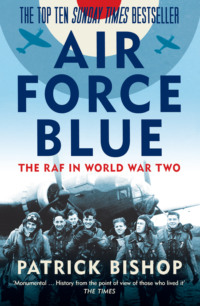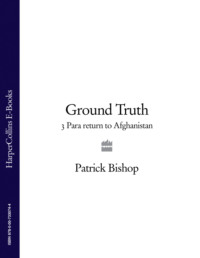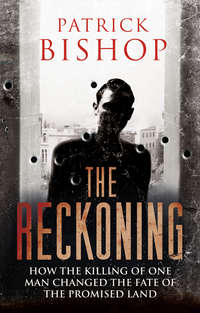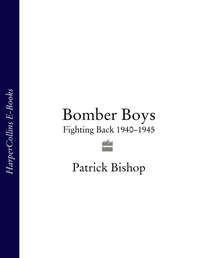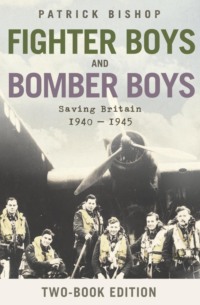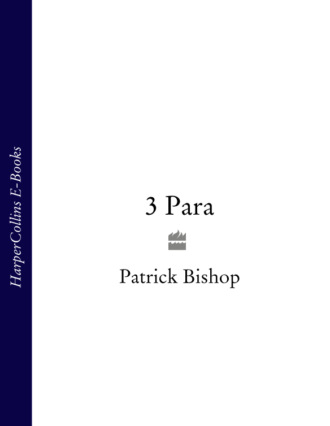
Полная версия
3 Para
The first British airborne assault took place in February 1941 when a small band of daredevils jumped into southern Italy and blew up an aqueduct. In the remaining four years of the war the Paras built a tradition as illustrious as that of many of the ancient regiments they fought alongside. They were in North Africa and took part in the invasions of Sicily and Italy. They played a key role in the Normandy landings, notably at Merville, where they knocked out a gun battery protected from air attack by 12-foot-thick concrete, which threatened the invasion fleet.
They were at the heart of the most famous airborne operation in history, Market Garden. The Paras, alongside two airborne divisions of Americans and one of Poles, were dropped 100 miles behind the German front lines to clear a corridor across the Netherlands for the advancing Allied armies. The 10,000-strong British 1st Airborne Division was all but wiped out and the key bridge at Arnhem it was tasked to capture remained in German hands. But the episode established an imperishable reputation for courage, resolution and coolness that was celebrated in the film A Bridge Too Far. During the Suez crisis in 1956, 660 paratroopers dropped into El Gamil airport in darkness, securing it in the face of heavy opposition.
Memories of Merville, Arnhem and Suez still colour the Para ethos. New recruits might not know the name of the last prime minister but one, but by the time they finish their training they will be fluent in the history of the regiment. This pride in the past provides a reservoir of spiritual strength to draw on in hard times. ‘We are here to uphold something that has gone before,’ said John Hardy, the 3 Para RSM. In nasty moments in Helmand, when fortitude was flagging, he would remind his men that their performance was under scrutiny, asking them, ‘The blokes who went through the war, through Arnhem – what would they think?’
The path to the Parachute Regiment is long and hard and strewn with obstacles. After an initial three-day selection, would-be paratroopers begin six months’ basic training at the army training centre at Catterick, a sprawl of brick blocks, plonked down in the rolling farmland of North Yorkshire. Inside its gates someone, somewhere always seems to be barking a command. No one walks and everyone marches. A surprising number are hobbling, poling themselves along on crutches. The chances are they are Para candidates whose limbs have failed to withstand the rigours of the course.
The training washes out the unfit and the unsuited. The final selection, for officers and men, is made at Pegasus Company – known as ‘P’ Company. It is designed to sort out whether or not you have the Para DNA. It is a rite of passage that those who have endured still talk about with pained awe years afterwards. It is above all a test of determination. ‘The thing about P Company, which is difficult to explain to anyone who hasn’t done it, is that it’s not really a physical test, it’s a mental test,’ said Captain Hugo Farmer, who won a Conspicuous Gallantry Cross in Helmand. ‘If you want it and you are determined enough, you will pass it. You have to have a reasonable degree of fitness, obviously, or you will fail early on. But it is people who are mentally tough that are wanted. That’s the most imporant thing.’
P Company lasts three weeks. The first two are taken up with daily battle marches with kit, squad runs and intensive circuit training sessions designed to physically exhaust candidates before the final ‘Test Week’ begins. This starts with a stint on the Trainasium – an aerial assault course over high, narrow walkways and a tower built out of scaffolding and wood. Candidates are ordered to do an ‘illusion jump’, which means running along a plank suspended 30 feet up and launching themselves at a cargo net 15 feet away. In this way, the instructors test whether the candidate can handle heights. It also tells them whether he will throw himself from a height without question. ‘It takes quite a lot to run up to the end of the plank and launch yourself off not knowing whether you will make that net or, if you do, if you will bounce off,’ remembered one survivor.
This is followed by a 10-mile battle march carrying full kit and weapon. The next day starts with a 2-mile steeplechase and three circuits of an assault course. Then comes the log race in which teams compete to carry a telegraph-pole-sized piece of timber over a difficult cross-country course. Anyone who fails to keep up can expect to flunk the course. Day Three begins with a 2-mile best-effort run with kit. The afternoon is given over to ‘milling’. This involves two candidates standing toe to toe, slugging it out for sixty seconds. The fighters are not allowed to defend themselves, only punch. They wear heavy, 16oz gloves and protective headgear, but many still finish the bout spattered in blood.
The candidates get the weekend off to recover. When they return, they are sent off on a 20-mile endurance march with full kit, weapon and helmet. The course ends with another cross-country race. This time the teams carry a ‘casualty’ on a stretcher. About half of those who try fail P Company. Many drop out through injury. Women have attempted it, but none has yet passed.
The successful candidates go next to RAF Brize Norton, where they undertake eight increasingly difficult parachute jumps, the last made in full kit at night-time.
Parts of the selection process seem at first glance to be anachronistic and out of tune with what is required of a modern professional army. ‘Milling’ is a term that dates back to the days of bare-knuckle prizefighting, and the Paras is the only regiment in the British Army to practise it. Arriving on the battlefield by parachute is almost as bizarre nowadays as turning up on a horse. The Paras, however, have an almost mystical belief in the value of jumping. They tried to get permission for a classic parachute drop operation in Helmand. The idea was rejected by higher authority as charming, but impractical.
Their loyalty to these habits is based on the belief that they have an intangible worth far greater than their apparent practicality. ‘When you are on the log race and and you have got 200 metres to go and you are absolutely knackered you do not give up,’ said Lieutenant Andy Mallet, an accountancy executive in his former life. ‘If anything you go faster. When you are in the ring and you are milling someone and they are bigger than you, you don’t give up, you keep milling. It’s that ethos that nobody else has.’
The final test of courage and commitment is the jump. At the end of training ‘your initial reaction is to do whatever you are asked, so when you are standing in the door of the aircraft and you see the green light go on and you are given “green on – go”, you go. It’s that principle that we take forward in everything we do.’
Jumping in the Parachute Regiment is not the same as sports parachuting. It involves, according to Stuart Tootal, throwing yourself ‘out of a perfectly serviceable aircraft at night with a heavy container of equipment often weighing upwards of a hundred pounds strapped to your legs, with another eighty or so people trying to leave the same aircraft … the hazards of doing that are quite significant’.
Whatever its tactical limitations in southern Afghanistan, Tootal felt that the psychological bolstering parachuting provided was a great preparation for what the Paras would face there. The nerves experienced waiting at Bastion to lift off to what might well be a ‘hot’ landing zone struck him as very similar to the low hum of dread that preceded a difficult jump. ‘Parachuting doesn’t allow you to conquer fear, but the experience of doing difficult parachute descents does give you a familiarity with managing it. Lots of people said that and I felt it myself. Regardless of what happened, I was fairly convinced, based on my experiences of parachuting, that I would do the right thing.’
Climbing out of the back of a Chinook into a Taliban ambush, ‘you might be thinking of the implications of being killed or wounded, but I think the biggest concern is how you’re going to perform. Are you going to freeze?’
The ‘green on – go’ reflex was the cure for that. ‘It doesn’t matter if we haven’t parachuted for years in an operational environment … it’s what that training experience gives you – the type of soldier it breeds.’
The toughness of the training and the ruthlessness of the selection create some marked characteristics. One is an intense feeling of camaraderie that blows down social barriers. Class and background seem unimportant. There is a feeling of communal concern and mutuality that is hard to find in life beyond the barrack walls.
Surviving the process, making the cut, also encourages feelings of superiority. Paras love being Paras. ‘They are the best at what they do,’ said Andy Mallet. ‘It doesn’t matter what anybody else says. I know, having served with the Third Battalion, The Parachute Regiment, we are the best regiment in the army without a shadow of a doubt.’
‘You have got the Guards regiments which are hundreds of years old, which can hark back to Waterloo, but that doesn’t matter,’ said Captain Nick French, the Mortar Platoon commander. ‘It doesn’t mean anything to you. We can hark back to victories in the Second World War, Suez, Northern Ireland, the Falkands. Instead of talking about history, the blokes make history. That is why we are so proud. We have proved ourselves time and time again as opposed to relying on some mystique that was created at Waterloo. That’s why the blokes are so fiercely proud of who they are.’
Private Peter McKinley, who won a Military Cross in Helmand, says simply, ‘We are airborne gods. The whole army hates us because we are fucking mega. They hate us for the way we act, the way we walk and hold our heads high.’
To be an elite requires someone else to be crap. In the eyes of the ultras of the Parachute Regiment, such as McKinley, that designation applies to everyone else in uniform. The phrase ‘crap hat’ is used for all who do not belong to the Parachute Regiment. No one knows where it comes from. It is usually abbreviated to just ‘Hat’. Nick French’s mobile phone tone is a recording of an old-fashioned voice declaring, ‘Paras believe in themselves and each other – everyone else is a crap hat,’ lifted from a 1980s documentary.
Para pride was on full display one wintry night at Colchester Barracks in 2007 when the 3 Para boxing team was taking on 2 Battalion, The Yorkshire Regiment – the Green Howards – in the semi-finals of an army boxing contest. On one side of the ring sat the ‘Toms’, as the foot soldiers of the Parachute Regiment call themselves. On the other were the Green Howard ‘Hats’. The officers of the two battalions, poured into scarlet bum-freezer mess jackets and tight black trousers, sat facing each other across the canvas. It was a late Victorian scene with only a pall of cigar smoke hanging from the rafters missing from the picture. ‘Drop the Hat! Drop the Hat!’ yelled the Toms. 3 Para’s fighters obliged, winning all but one of the bouts. In the seventh fight, a spectacular knockout within twenty seconds of the first round brought every Para in the hall leaping and cheering to his feet. At the end of the evening the Green Howards trudged out into the dank Essex night where coaches were waiting to trundle them off on a joyless three-hour journey home. The Paras streamed away to the messes for a night of drinking and revelry.
A sense of fun and outrage forms a structural part of the Paras’ image. In this too they regard themselves as superior to the rest. Their attitude is illustrated in a series of cartoons stuck on the wall of a senior NCO’s office in Catterick. The first shows the contrast between a Tom and a Hat in their off-duty down time.
The Tom has a shaven head (‘deters pubic lice’) and is wearing an old bomber jacket and jeans, the knees of which are heavy with grass stains from an illicit, al fresco bunk-up. He clutches a foaming beer bottle in one hand. The Hat is primly attired in a blazer with a bowls club-type crest on the breast pocket. He sports a gelled, tinted and highlighted ‘Take That’ haircut and is wearing ‘gay’ socks. He too is drinking – a bottle of low-alcohol gnat’s piss.
The message is that the Paras are desperadoes, real men in an age of wimps and wusses. They care little about their appearance and detest bullshit. But when it comes to the battlefield the roles are reversed. In the cartoons that follow, the Tom is in immaculate battledress, his gleaming weapon lovingly maintained. Here, clearly, is a man who is overjoyed to be where he is. The Hat, on the other hand, is a shambles. His uniform is wrinkled, his rifle is dirty and his expression suggests he would rather be out clubbing.
The cartoons are, of course, a gross libel on non-Paras. But there is some truth in the picture of the Tom. It is certainly how some of them like to portray themselves to the outside world – that is, in the worst possible light. Some members of 3 Para were well known to the Colchester constabulary. The Toms’ favourite boozer was the Fox and Fiddler, their favourite drink a Cheeky Vimto, an appalling concoction made up of one bottle of Blue WKD with two shots of port and plenty of ice. It could be a recipe for trouble when the pub closed.
‘You will find there is very much a live today, die tomorrow attitude among the blokes,’ said Nick French. ‘They blow their wages, get up to all sorts of antics in town with people they shouldn’t.’ But the fun is rationed. The cartoons are accurate. To the Para mentality, it is the battlefield that matters and everything, ultimately, is subordinate to preparing for it.
Despite the shared beliefs and characteristics, the men who went to Helmand were a diverse bunch. Membership of an elite also implies tolerance towards fellow members of the club. Individualism, the courage to be yourself, was regarded as a Para virtue.
All military units are shaped to some degree by the personality of their commanders. In Stuart Tootal, 3 Para had a leader who was complex and reflective, but also assured and determined to succeed. He took over command in October 2005 from Lieutenant Colonel Matt Lowe, described by one of his officers as a ‘good old-fashioned CO … rather aloof’. Another regarded the two men as ‘two different beasts. Matt Lowe was more considered in his outlook. Stuart is probably a bit more intuitive, instinctive, more aggressive.’
Tootal was forty-one at the time of the Helmand deployment. He arrived relatively late to the Parachute Regiment, and adopted its ways with all the zeal of the convert. He came from a strong military background. His grandfather was in Bomber Command and was killed over Germany. His father, Patrick, was a career RAF officer who ended his service as a group captain. Tootal went through a statutory rebel phase as a teenager. His father remembers him turning up to meet him at the Ministry of Defence building in Whitehall wearing a Greenpeace T-shirt. But he had taken to heart Samuel Johnson’s maxim that every man thinks less of himself for not having been a soldier. He joined his school’s Combined Cadet Force and after studying history and politics at London University went to Sandhurst. He was commissioned in 1988 and joined the Queen’s Own Highlanders. He served in Northern Ireland and was in the desert for the first and second Gulf Wars. On the way to his command he studied for a master’s degree in international relations at St John’s College, Cambridge, and an MA in war studies at King’s College London, where he later spent six months on a visiting defence research fellowship. This made him a very well-educated officer, even in the modern British military, where academic achievement is admired. His main area of expertise was counterinsurgency. He had had a chance to study it first-hand when he went to southern Iraq in 2003 as second-in-command of 1 Para.
At the time of the Helmand deployment Tootal was a bachelor with no family distractions to blunt his appetite for work. He expected the same degree of dedication from his men and worked those under him hard. Yet no one doubted his commitment to his men. ‘When Colonel Tootal came in it was quite clear that he had a human side,’ said one of his platoon commanders. ‘His heart was very much in the right place. He cares a lot about the blokes and their welfare and he wants to look after them. We instantly respected him because he had the right priorities. He didn’t treat the blokes like assets.’
Tootal was supported by a second-in-command who was not afraid to challenge his boss’s thinking. The phlegmatic approach of Major Huw Williams was much appreciated in the many moments of crisis. ‘Huw was a great foil to Stuart,’ said one officer. ‘When he came up with a proposal he would say to him, “Yes, this is plausible, no, that is not.”’ They made a good team and won the confidence of those who had to execute their orders ‘We were all happy with what was coming down from above,’ said one platoon commander. ‘I never heard anyone say, “This is fucking stupid, this is madness.” [They] just came up with good sensible plans … you can’t ask for more than that.’
During the Helmand campaign Tootal would come to rely greatly on the support of his regimental sergeant majors. Nigel Bishop was his RSM for the first three months until he moved on to another posting. He was replaced by John Hardy, a twenty-year veteran known as ‘the Razman’ to the troops, who regarded him as a surrogate father. His relationship with Tootal was a vital element in the battalion’s human chemistry. Tootal was the senior officer. Hardy was the senior soldier. As such, they had a bond that transcended the vertical hierarchy. ‘I bark to one man and that is the CO,’ Hardy said. ‘I don’t wag my tail for anyone else.’ Hardy had many responsibilities. The most important, though, was to act as a conduit between the blokes and the boss – ‘telling the CO how it was’.
3 Para, like all infantry battalions, is configured in tiers. At the top is the CO (commanding officer) and his headquarters staff, who manage and direct the battalion. The fighting soldiers are formed into companies. Each company is divided into two or three platoons and each platoon into sections. The number of men in a company varies, but it can be as many as a hundred or as few as sixty. In 3 Para ‘A’, ‘B’ and ‘C’ Companies were the rifle companies, the basic fighting unit. They were sustained and augmented by Support Company, which provided additional firepower in the shape of machine guns, mortars and anti-tank weapons. ‘D’ Company was the ISTAR company providing specialised Intelligence, Signals, Target Acquisition (snipers) and Reconnaissance expertise.
Each company was commanded by a major. At thirty-six, Will Pike, the OC (Officer Commanding) ‘A’ Company, was the most senior. He was the son of Hew Pike, who led 3 Para in their days of glory in the Falkands, and had his father’s strong, square features and thick, blond hair. He had long ago given up worrying whether this connection was an advantage or a burden. ‘In the end I don’t think it makes a blind bit of difference,’ he said. ‘I don’t think that anyone else thinks that either.’ Those under him sometimes felt he was hard to please, but noted he was as tough on himself as he was on others.
‘B’ Company was commanded by Giles Timms, a blunt, cheerful fitness fanatic, who had been destined since adolescence for military life. He joined the Combined Cadet Force of his public school. After learning of the army sholarship scheme, ‘everything I lived and breathed from then on was geared to getting into the army’. He joined 4 Para, the reserves, as a private soldier while at university. The artillery sponsored him through Sandhurst, ‘but my allegiance was really to the Parachute Regiment’. It was only at the last minute that he told his sponsors that he would not be joining them. ‘I got quite a hard time for that, for disloyalty. [But] you have got to be true to your own ambitions and I wouldn’t have been happy in the Gunners.’
‘C’ Company’s OC, Paul Blair, known as Paddy, was a soft-spoken, good-looking Ulsterman with a gentle, courteous manner. He did a four-year business course before deciding that office life was not for him and set off for Sandhurst in July 1995. Cadets are required to put down a first and second choice of regiment they want to join when they pass out. ‘I was very much, it’s the Parachute Regiment or nothing,’ he remembered.
Adam Jowett, who commanded Support Company, joined the Paras from the Grenadier Guards and served with them in Kosovo and Sierra Leone. He was working in a staff job when the word came through that 3 Para were likely to be sent to Afghanistan but wangled his way out of it to go with them. Jowett was the most reserved of the company commanders, but a robust soldier when the time came.
For all their combined experience, in the spring of 2006 there were only three men in 3 Para who could claim to have had real experience of a proper war. These were the last remaining members of the battalion who had served in the Falkands campaign. The intervening years had been spent in worthy but uninspiring deployments that hardly matched the expectations of 3 Para’s members when they joined up. As they prepared to leave their drab headquarters in Colchester for the burning plains, soaring mountains and lush river valleys of Helmand province, the atmosphere was charged with the premonition that things were changing. 3 Para were about to get what they wished for.
Конец ознакомительного фрагмента.
Текст предоставлен ООО «ЛитРес».
Прочитайте эту книгу целиком, купив полную легальную версию на ЛитРес.
Безопасно оплатить книгу можно банковской картой Visa, MasterCard, Maestro, со счета мобильного телефона, с платежного терминала, в салоне МТС или Связной, через PayPal, WebMoney, Яндекс.Деньги, QIWI Кошелек, бонусными картами или другим удобным Вам способом.




